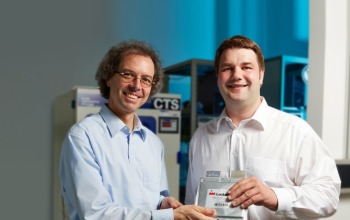Safe Lithium Batteries with a Long Service Life

As part of the joint research project Intrinsically Safe Battery (EiSiBatt), which is funded by the German Ministry for Economic Affairs and Energy, the engineers developed a new cell chemistry until it was sufficiently mature for general application.
As a result, it is now possible to create lithium-ion batteries that are very safe, even when they are overcharged, and that last for a much higher number of charge-discharge cycles (20,000) than the previous top value of around 5,000.
Lithium-ion batteries are very attractive energy storage systems, due to their high energy densities. In Siemens products alone, their areas of application range from small energy storage systems for hearing aids to medium-size storage systems for cranes and machine tools, and large storage systems for power grids.
The anodes of the new battery cells do not consist of graphite, as is usually the case, but of lithium titanate, while the cathodes are made of lithium iron phosphate instead of a lithium-metal oxide.
In addition, scientists at Siemens' global research unit Corporate Technology in Erlangen have developed a model that simulates the behavior of battery systems in which hundreds of the new cells are interconnected. This is the case, for example, with compact and large storage systems.
After numerous measurements and simulations, the scientists managed to understand the batteries' behavior and to describe it mathematically. The model not only encompasses the batteries' electrical behavior, but also their mechanical and thermal behavior.
The simulations enabled to scientists to find out how the new batteries' output and energy content are affected when the batteries are used to stabilize power networks or regulate frequencies, for example.
Facilis A team of engineers at Drive Technologies in Chemnitz developed the associated battery management system, which controls the cells' charge level. To ensure a smooth interaction, the engineers used components available from Siemens for the system concept.
For example, a Simotion control system analyzes the cells' voltage and temperature. This enables the software to take on additional tasks, such as when the battery is incorporated into a power grid or a drive network.
The new cells might give a variety of Siemens business areas a competitive edge. A demonstrator has already been created with which engineers can test various possible applications.
The project's participants also included specialists from the specialty chemicals company Clariant, the battery manufacturer Leclanché, and the Centre for Solar Energy and Hydrogen Research Baden-Württemberg (ZSW).
Media Contact
All latest news from the category: Power and Electrical Engineering
This topic covers issues related to energy generation, conversion, transportation and consumption and how the industry is addressing the challenge of energy efficiency in general.
innovations-report provides in-depth and informative reports and articles on subjects ranging from wind energy, fuel cell technology, solar energy, geothermal energy, petroleum, gas, nuclear engineering, alternative energy and energy efficiency to fusion, hydrogen and superconductor technologies.
Newest articles

Zap Energy achieves 37-million-degree temperatures in a compact device
New publication reports record electron temperatures for a small-scale, sheared-flow-stabilized Z-pinch fusion device. In the nine decades since humans first produced fusion reactions, only a few fusion technologies have demonstrated…

Innovative microscopy demystifies metabolism of Alzheimer’s
Researchers at UC San Diego have deployed state-of-the art imaging techniques to discover the metabolism driving Alzheimer’s disease; results suggest new treatment strategies. Alzheimer’s disease causes significant problems with memory,…

A cause of immunodeficiency identified
After stroke and heart attack: Every year, between 250,000 and 300,000 people in Germany suffer from a stroke or heart attack. These patients suffer immune disturbances and are very frequently…





















